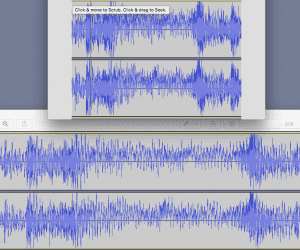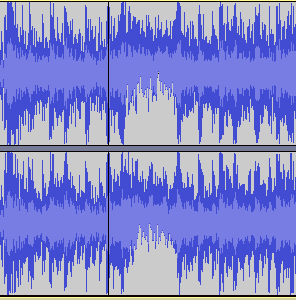You are using an out of date browser. It may not display this or other websites correctly.
You should upgrade or use an alternative browser.
You should upgrade or use an alternative browser.
What is this??
- Thread starter Hasen6
- Start date
Does really no-one know what this is? It had me baffled as well. It's not photoshopped or anything, this is the real waveform. I thought someone would recognise it and says it's 'dc offset' or something. It's not dc offset of course but surely someone has come across this before...
germancomponist
Senior Member
How does it looks like if you zoom the waveform in and out?
AdamKmusic
Senior Member
Some weird automation going on in your track?
No there's no automation in the track yet. I've attached the zoomed image. I thought waveforms were always supposed to be symmetrical (or near enough) so I thought this must be weird. I didn't think automation can really lead to asymmetrical waveforms. I guess it must be weird since I thought you guys would recognise it straight away and it was just my lack of knowledge but seems not.


Divico
Senior Member
+1 for assymetry. If interested Id recommend this article: https://www.soundonsound.com/sound-advice/q-why-do-waveforms-sometimes-look-lop-sided
Yeah it sounds fine, it's a weird sounding synth patch playing at that point just after some heavy percussion. It's like three bars of percussion and then it pauses for a bar and the weird synth plays and that's where we get the bite out of the waveform. It does sound fine but it looks really odd. Thanks for the link about asymmetrical waveforms.
averystemmler
Active Member
Yeah it sounds fine, it's a weird sounding synth patch playing at that point just after some heavy percussion. It's like three bars of percussion and then it pauses for a bar and the weird synth plays and that's where we get the bite out of the waveform. It does sound fine but it looks really odd. Thanks for the link about asymmetrical waveforms.
My guess is that synth has something pretty dramatic going on in the low end, possibly below 20Hz. A sufficiently low frequency, high amplitude sound will give the appearance of a "bias" of sorts, where the whole waveform moves with it.
Have a look on a spectrograph or frequency analyzer, and try a high pass at 20Hz or so, and see if it goes away. You might not hear it, but it could potentially be bad for a speaker or rumble a sub.
That's a good guess! Yeah it does go crazy in the 10-20 hz range, I didn't notice that before. It's weird because the sound itself doesn't feel that bassy, it has activity in the high mids and even more activity in the highs at 4k. What's even weirder is I noticed the audio file only has this bite out of it in Audacity, not in my DAW.My guess is that synth has something pretty dramatic going on in the low end, possibly below 20Hz. A sufficiently low frequency, high amplitude sound will give the appearance of a "bias" of sorts, where the whole waveform moves with it.
Have a look on a spectrograph or frequency analyzer, and try a high pass at 20Hz or so, and see if it goes away. You might not hear it, but it could potentially be bad for a speaker or rumble a sub.
Anyway, a high pass at 20 hz gets rid of it indeed and the waveform looks normal now.

averystemmler
Active Member
Huzzah! I once had a rogue Reaktor ensemble that was emitting a <10Hz tone at all times and causing a similar effect. Some softsynths are still the wild west!
Eldhrimnir
New Member
It's weird because the sound itself doesn't feel that bassy,
Well, 10-20Hz wouldn't really affect the sound in a perceivable way, so.
I mean it's weird to have such low frequencies in a sound that is not even a bass sound. No use at all and would kill everyone in the cinema for no real reason.Well, 10-20Hz wouldn't really affect the sound in a perceivable way, so.
SchnookyPants
I never metaphor I didn't like
I usually roll-off (sharply) somewhere between 25-30hz for "protection" purposes, just in case someone's got a great system.
Fredeke
Senior Member
It is possible to have sub frequencies in a non-bass sound: for example, if the mic recorded vibrations along with the intrument. There can be other reasons as well. And you wouldn't hear it if it's below your speakers' bass capabilities.
About asymetrical waveforms (that wasn't it, but here's my 2 cents anyway) : when recording synths from the jack, I often get a seemingly asymetrical waveform.
However, if you compare the "surfaces" above and below the 0-axis, they are the same. The real world meaning of this is that while peaks in one polarity rise higher than in the other one, they also last shorter. So the average amount of energy in both polarities remains the same over time. (Even over very short times, as long as it's at least a few cycles.)
About asymetrical waveforms (that wasn't it, but here's my 2 cents anyway) : when recording synths from the jack, I often get a seemingly asymetrical waveform.
However, if you compare the "surfaces" above and below the 0-axis, they are the same. The real world meaning of this is that while peaks in one polarity rise higher than in the other one, they also last shorter. So the average amount of energy in both polarities remains the same over time. (Even over very short times, as long as it's at least a few cycles.)
Last edited:
It is possible to have sub frequencies in a non-bass sound: for example, if you the mic recorded vibrations along with the instrument. There can be other reasons as well. And you wouldn't hear it if it's below your speakers' bass capabilities.
Yes I was just remarking I didn't see the point in a non bass sound to have such strong bass frequencies. You can have bass frequencies in virtually any instrument which is why we have the trend to roll off the low frequencies of virtually everything to all the bass and kick to occupy that area. Or at least in EDM that's what they like to do.
Yes I'm not sure whether it's really that much of a problem, even though it looks weird. It was with the soft synth Zebra and recently I saw it again in a Diva bass patch. It's always patches with bass frequencies but I found rolling off the 30 hz doesn't appear to always fix it but it does make it less noticeable. Although I didn't do a brick wall low cut.About asymmetrical waveforms (that wasn't it, but here's my 2 cents anyway) : when recording synths from the jack, I often get a seemingly asymmetrical waveform.
However, if you compare the "surfaces" above and below the 0-axis, they are the same. The real world meaning of this is that while peaks in one polarity rise higher than in the other one, they also last shorter. So the average amount of energy in both polarities remains the same over time. (Even over very short times, as long as it's at least a few cycles.)
Fredeke
Senior Member
Yes I was just remarking I didn't see the point in a non bass sound to have such strong bass frequencies. You can have bass frequencies in virtually any instrument which is why we have the trend to roll off the low frequencies of virtually everything to all the bass and kick to occupy that area. Or at least in EDM that's what they like to do.
Right. I should have got that. Of course I wasn't gonna teach anybody here anything new

Yes I'm not sure whether it's really that much of a problem, even though it looks weird. It was with the soft synth Zebra and recently I saw it again in a Diva bass patch. It's always patches with bass frequencies but I found rolling off the 30 hz doesn't appear to always fix it but it does make it less noticeable. Although I didn't do a brick wall low cut.
As someone said here, the only issue is that you're not using your wave file's whole dynamic range, but with today's bit depths, who cares ? I suppose it could be a problem in some very particular instances, but I can hardly think of one.
Someone also said it can throw off level detection in compressors, so there could be that too. (Never heard of this before, but it seems plausible)
What you could do to "correct" this is add a DC-like offset in order to get positive and negative peaks the same distance from maximum level, and then normalize. Then you would actually use the whole dynamic range.
But since I never tried that, I don't know which new problem it would create (if any).
Last edited:
Share:






